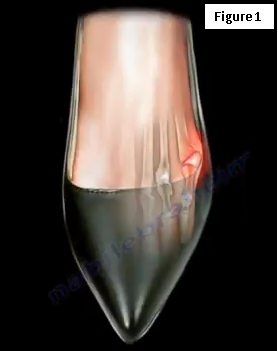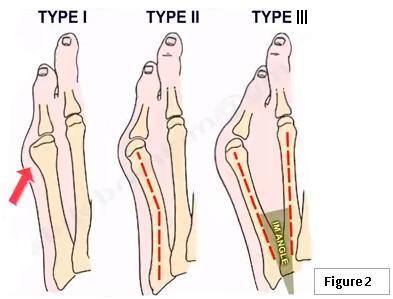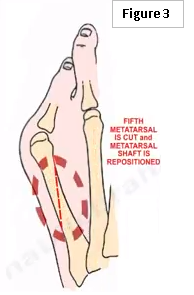A bunionette, also known as the “Tailor’s Bunion”, is a deformity of the little toe (5th metatarsal) whereas a bunion, is a deformity of the big toe (1st metatarsal). It is a prominence usually found at the lateral part of the fifth metatarsal head. Pain can result from bursitis which can happen due to the rubbing of the fifth metatarsal head prominence against the shoes (Figure 1). The patient usually has a widened forefoot and may have hyperkeratosis— a thickened callus. This condition tends to occur more in women and can be bilateral. Bunionettes can be diagnosed with a weight-bearing AP view radiograph.

The type of bunionette will determine the treatment method. There are three types of bunionettes (Figure 2):
- Type I— the fifth metatarsal head is enlarged and there is normal alignment
- Type II— Lateral bowing of the diaphysis of the fifth metatarsal
- Type III—Widened fourth and fifth metatarsal angle (More than 8° is considered pathologic)

Treatment
Nonoperative treatment for bunionettes have a high success rate. Nonoperative treatment typically consists of anti-inflammatory medications and orthosis. It is necessary for the patient to wear proper shoes with a wider toe box and padding at the prominence area. Surgery is rarely needed.

In cases where surgery is required, a resection of the lateral part of the fifth metatarsal head will be performed for Type I bunnionettes. Type II will require a distal metatarsal osteotomy—the fifth metatarsal is cute and the metatarsal head is repositioned. An oblique diaphyseal osteotomy for Type III bunionettes are performed when the intermetatarsal (IM) angle is more than 12° (Figure 3). The surgeon should avoid a proximal osteotomy in the fifth metatarsal due to the possibility of interrupting the important blood supply and the high rate of nonunion.
For more information about conditions of the foot, follow the links below:
For more information on Orthopaedic Conditions visit me on YouTube at:
